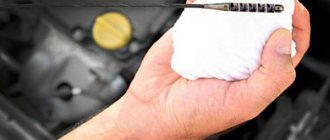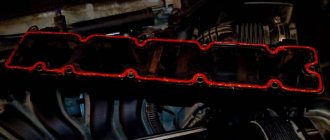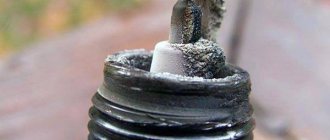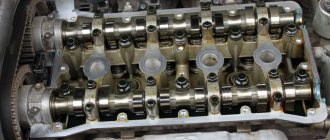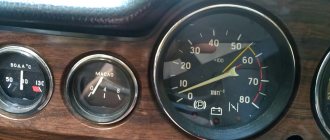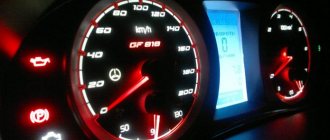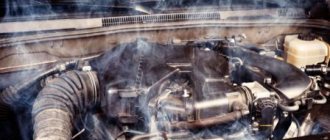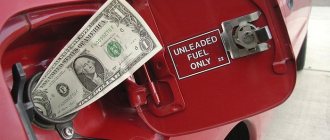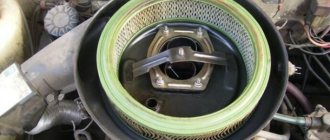How to choose the right valve cover gasket
This must only be an original spare part. You should compare it with the serial number from the catalog. As a rule, high-quality consumables for this purpose are made from good elastic rubber, without smudges, sagging or variations in thickness in one product. All these little things will help keep the motor sealed longer.
Should I use sealant when installing the gasket or not? There are several opinions. Some argue against this method of sealing, and a number of mechanics are the only way to complete engine repairs in the event of an oil leak.
If the valve cover has already been replaced and has a somewhat uneven surface, then sealant can be applied for greater adhesion to the cylinder head. But this should be done in a thin layer. If the joining surfaces are perfectly smooth and do not bother you, then you can do without sealant.
There are cars whose design does not provide for the installation of a gasket. In this case, the use of sealant must be mandatory.
Fixing a leak using the example of a Chevrolet Niva
The design of Chevrolet Niva engines is almost similar to that installed on a domestic car, and therefore has characteristic problems. When there is a leak, tightening the nuts and bolts often does not work, forcing you to look for alternative options.
Chevrolet Niva uses tin covers. To avoid deformation of the plate during tightening, washers-plates are installed under the nuts. This does not save, but it increases service life by slowing down the deformation process. Repair in this case may involve leveling the surface. To do this, the CC must be removed, placed on flat metal and walked over the uneven surfaces with a hammer.
If the ventilation of the VAZ Chevrolet Niva engine is dirty, straightening the AC will not solve the problem. The entire system needs to be cleaned. In this case, the cover may remain in place: the breather, which needs cleaning, is located on the left, under the cylinder head mark.
You can clean it by removing the ventilation pipe and unscrewing the fastening with a 13 key. The breather must be washed in kerosene and wiped thoroughly. Cleaning should also be carried out at the installation site, making sure that dirt does not enter the ventilation through the open duct.
Causes
For what reasons can motor fluid leak from under the crankshaft oil seal (hereinafter referred to as SCV)? This question interested every car enthusiast who encountered this problem. Now we will try to give a detailed answer to this question. There may be several reasons, as you might understand.
Oil leak from under the front SCV
First, you must decide which oil seal is leaking. There can be two of them in a vehicle:
- Rear oil seal. As a rule, its service life is long and is often determined by the life of the vehicle. In terms of its dimensions, this element is large.
- Front oil seal. It is smaller in size, but it is also less durable, since in practice it fails much more often than the rear oil seal.
You must clearly know which oil seal is leaking. If an oil leak has been detected at the rear of the engine, then it is necessary to visually check the pan and gearbox unit. To understand what kind of oil is flowing, drop it on the surface of the water. If the transmission fluid immediately spreads across the water surface, the engine fluid will remain in a droplet.
Loading …
Now let's move directly to the reasons why the crankshaft oil seal may leak. As stated above, there may be several of them:
- One of them can usually leak when the total mileage of the vehicle exceeds 100 thousand kilometers. This is often caused by vibrations in the crankshaft, which wears out the inside of the oil seal, which should initially be a tight fit. However, as it breaks down and loses its shape over time, it cannot adhere tightly to the crankshaft surface.
- In addition, the problem may arise in another case. For example, if the vehicle has not been used for a long time or has been parked outside for a long time during winter cold, the oil seal may dry out or freeze and harden due to frost. In this case, it will also not be able to press tightly against the surface of the crankshaft.
- As for new elements, the oil seal may leak for other reasons. In particular, it may be the disgusting quality of the manufactured part itself. Please note that poor quality of the element will one way or another affect its performance, so do not install products from unverified manufacturers on your vehicles.
- Incorrect installation. It is also one of the reasons why oil leaks from under the oil seal. In particular, this is possible if the element is installed unevenly. As a rule, the oil seal is installed in the required position and, using a hammer, without applying any effort, the oil seal is hammered into its installation location. However, oil seal manufacturers recommend that their consumers use special equipment for this.
- Engine malfunction. Engine fluid leakage can also occur due to a malfunction of the internal combustion engine itself. If defects appear in the operation of the engine, for example, the pressure of crankcase gases in it has increased, then these same gases can simply squeeze out the oil seal. As a result, a gap may form at its point of contact with the crankshaft, through which lubricant will flow out.
- Oil filter leaking. Also a common problem. Sometimes motorists mistake this problem for a seal leak and change the seals, as a result of which the filter will still need to be replaced.
Car engine disassembled
Now let's clarify some details about the production of oil seals. You should not purchase parts from unverified sellers or manufacturers unknown to you. This way, you can not only buy a low-quality oil seal, the installation of which will backfire on you, but will also cause new problems. Well-known and trusted manufacturers of elements today are:
- Victor Reinz;
- Elring;
- Goetze.
It should be noted that the products of these companies end up not only in automobile stores, but also in the used parts market.
Main causes and ways to eliminate them
Replacing the valve cover gasket: how to do it?
There can be many reasons that cause oil leakage, there can be several main ones, let’s look at them:
| Malfunction | Remedy |
| During installation, they forgot to lubricate the rubber of the oil filter barrier and it became skewed or deformed during tightening | Remove the barrier, lubricate the rubber and reinstall |
| After replacement, the oil filter was not tightened | Tighten until it stops, but only with your hands without using tools. |
| Leaking due to the oil filter being overtightened during replacement | Remove the barrier; if the elastic band is deformed, replace it and install a new one without using excessive force |
| Damage to the sealing surface of the barrier (the ebb surface on the motor in contact with the rubber band) | Replace barrier |
| High lubricant pressure in the engine | There are many reasons, the oil or barrier may need to be changed |
| Unheated car. On old-style models, oil pumps are installed in which there is no oil pressure relief valve, in case of excessive increase, and the external auto-valve is either not installed or is faulty | Warm up the car, inspect the pump and valves |
| Dirty filter element | Replace the barrier. When changing the filter, tighten it only by hand. Just tighten it well. Because if you tighten it with a wrench, there is a risk of squeezing out the rubber and causing a leak again. |
If everything is in order with the lubricant and filter, but the oil is squeezed out again, then perhaps the pump itself is faulty, namely the auto-reducing valve.
Advantages and disadvantages
Vinyl films have many advantages, but one of the main ones is that the cost of vinyl stickers is relatively low. Pasting the entire body will cost about 30 thousand rubles, and the cost of applying vinyl to individual body elements will be 5-6 thousand rubles, which is quite affordable for most car enthusiasts. The same airbrush will cost 3-4 times more. If we compare it with the Oracal adhesive film, which belongs to the category of inexpensive films, then this difference will be even greater.
Noticeable cost savings when using vinyl films also occur due to the fact that the idea for a future image can be gleaned from the Internet. In this case, you won’t have to resort to the expensive services of a professional artist. And if you have skills in working in the Corel Draw program, then you can even draw a sketch of the future image yourself. And in this case, the DIY car sticker will be one hundred percent original. With the same ease, you can place advertising on your car.
It is also important that the vinyl coating performs a protective function, protecting the body from chips and scratches. And thanks to the relatively large thickness of some films, they can even protect the side of the car, which suffers the most in urban conditions. In addition, vinyl stickers can hide almost any flaws on the car body, which will allow you to avoid having to repaint it and, in the end, again allow you to save a lot of money.
If circumstances change, then the vinyl film can be removed from the car body as soon as possible. But in this case, you must be prepared for the fact that the part of the body on which the film was not applied will be slightly different in color from the places where the vinyl sticker was located. This is due to the fact that the pigmentation of the base paint on the body changes slightly under the influence of sunlight. After some time, everything will return to normal, but at first the differences may be noticeable. This is the main disadvantage of vinyl stickers.
Oil leaking from under the cylinder head is a serious problem
A very unpleasant moment, familiar to many motorists, is when oil leaks from under the cylinder head.
Many, especially novice car owners, do not pay attention to this, especially if only a couple of drops are leaking. However, if you leave this whole thing to chance, then a harmless “couple” of drops will soon turn into a trickle, and after some time there will be no oil left in the engine at all
Why is oil leaking?
The main reason for this lies in the malfunction of the head itself and the gasket under it. The oil line and coolant pass through the cylinder head, so if the oil line is damaged, oil will begin to flow into the cooling system and will leak from under the head. This type of leakage is also an indication of a damaged head gasket.
The consequences can be the most unpleasant - as the oil decreases, the lubrication of the engine's rubbing parts will deteriorate, which will very soon lead to their jamming. And this will entail, at a minimum, a major overhaul of the engine.
What to do if oil leaks from under the cylinder head? The most important thing is to establish the cause - after all, oil may be leaking from under the valve cover. As soon as the cause of oil leakage is established, you need to immediately take measures to eliminate it - simply wiping off the oil stains and calming down will not be enough. If oil is leaking from under the valve cover, then the gasket is most likely damaged.
Although it is made of high-quality oil-resistant rubber, nevertheless, this sometimes happens. If oil leaks directly at the junction of the cylinder head and the block, then there may be several reasons - improper tightening of the bolts, damage to the gasket, and, most unpleasantly, damage to the head itself.
Some car owners, having discovered that oil is leaking from under the cylinder head, do not understand the seriousness of the situation. And the lack of oil is compensated for by periodically adding it. Such a solution is completely unacceptable - after all, at the most inopportune moment the engine may fail. And no one can say when this will happen. But even after eliminating the malfunction, it is advisable to monitor the oil level not only by the sensor, but also by checking it with a dipstick. It might seem like a harmless drop of oil, but if you don’t take action, it can lead to major troubles. Therefore, it is strongly recommended to take corrective action as soon as possible upon detection.
The cause of the leak is damage to the cylinder head gasket.
If you find that oil is leaking from under the cylinder head, this means that the gasket is damaged. This happens in most cases due to repeated overheating of the engine. Damage to the gasket can result in oil leakage, coolant entering the cylinders or into the oil line, or exhaust gases entering there. Well, the cause of overheating itself can be different - driver inattention, malfunction of any mechanism - for example, a water pump, thermostat, radiator - the presence of leaks. In any case, if the engine overheats, this is a consequence of the driver’s inattention, since this can be prevented.
However, this does not always mean that the cylinder head or the gasket under it has failed - most of these cases occur due to the fault of unskilled craftsmen who either poorly cleaned the surface of the cylinder block and did not remove the remains of the old stuck gasket, or simply performed the cylinder head repair incorrectly. To eliminate the leak, you can try re-tightening the bolts according to the diagram, and if this does not help, you will have to remove the head again. But in any case, if oil is leaking from under the cylinder head, you should not close your eyes; this is a cause for serious concern. Therefore, it is best to immediately go to a service station.
Possible leak locations
If you notice oil leaking from under the valve cover, try to pinpoint the location of the leak. Most often, lubricant can leak:
- at the junction of the cover with the cylinder head due to wear of the gasket or excess pressure in the system;
- in places where the cover is bolted to the cylinder head;
- from the oil filler neck.
In rare cases, an oil leak may occur on the cover body itself. This may be the result of mechanical damage or a manufacturing defect during casting.
Studs, nuts and other connecting elements
Often the cause of leakage is improper broaching. If for some reason it becomes necessary to remove the valve cover, it should be firmly tightened when installing it back. It happens that bolts and studs break off. Often we are talking about the human factor, when due to great efforts the thread breaks. In such cases, the connecting elements should be replaced with new ones.
Modern covers have metal bushings for each bolt. They are necessary for pressing special gaskets lying in the wells of the attachment point. Sometimes the sleeve is ground down a little along the length. This action allows you to better press the gaskets. Action in some situations allows you to stop the leak.
The bolts that press the cover to the plane of the head can stretch out over time, and the metal can become tired. Therefore, some professionals recommend changing the bolts at every oil change.
Recommendations
High-quality leak elimination involves choosing the correct gasket for the cover. It is best to purchase original products or analogues from well-known manufacturers. Before purchasing, be sure to examine the item and check for elasticity. There should be no sagging or other defects on it. Do not buy if the material has cracks or appears dry.
If the mating surfaces do not have a smooth surface, sealant can be used. It provides better connections and seals. Remember that the service life of such a gasket is short. If there is no defect on the surfaces, then it is better not to make additional layers.
During installation and tightening of bolts, all manufacturer's recommendations must be followed. The bolts are tightened only in a certain sequence with a specific force.
- Replace the engine oil and filter in a timely manner.
- You should only buy high-quality lubricant.
- Do not allow dirt, water or other process fluids to enter the lubrication system.
- When undergoing a technical inspection, the pressure in the system should be checked.
- Do not allow the engine to overheat.
In conclusion, we note: if the problem is in the seal, then it is enough to simply replace it. As pressure increases, the problem becomes more difficult to resolve. Sometimes cleaning the channels helps, but most often the problem appears due to more serious faults that require an integrated approach.
The valve cover is an integral part of the internal combustion engine, which is needed to protect the timing belt from the penetration of moisture and dirt. In addition, the valve cover prevents the oil, which lubricates the timing elements and comes under pressure, from splashing the space under the hood. For greater tightness, the valve cover is attached to the cylinder head through a special gasket. In the newest car models, instead of a gasket, a layer of sealant is used
If an oil leak is detected, it is extremely important to find the exact location of its leakage
Oil can leak through the following places:
- through the neck;
- where the cover connects to the cylinder head;
- where the valve cover is bolted to the cylinder head;
Occasionally, a leak can be seen on the valve cover body. This can happen if the cover was damaged during operation, or it was initially defective.
Why is oil leaking from under the valve covers?
Let's say right away that if an oil leak is detected at the place where the valve covers are bolted to the cylinder head, or oil flows from the neck, then there is only one reason - increased pressure in the lubrication system.
If a leak is found at the junction of the cover with the cylinder head, then this is either high pressure or the gasket between the cover and the cylinder head is worn out.
The gasket is constantly exposed to high temperatures, therefore, over time, it naturally wears out: it loses its elasticity, cracks and ceases to fit tightly to the surfaces of the parts. To restore tightness, it is enough to replace the worn gasket with a new one.
The second reason for oil leakage is a more serious case. We need to figure out: why did the pressure rise in the system? But first, the pressure needs to be measured.
How to measure oil pressure
To circulate lubricant in the timing belt, the oil pump creates pressure. Oil, under this pressure, circulates through the oil channels inside the engine. For different engines, the oil pressure level is different. To find out exactly what oil pressure your vehicle should have, check your vehicle's Owner's Manual for this information.
If the oil pressure decreases, the oil pressure gauge on the dashboard will immediately light up. But it will not be possible to determine, using this sensor, an increase in oil pressure in the system, since it will not light up when it increases.
What is a valve cover?
This element of the internal combustion engine is designed to protect the gas distribution mechanism from dirt, dust and moisture entering it. In addition, the cover protects the entire engine compartment from oil, which is supplied under pressure to lubricate the timing belt.
The first internal combustion engines did not have a valve cover, which is why the gas distribution mechanism had to be constantly washed and cleaned. Over time, the timing belts began to be covered with stamped covers made of thin sheet steel. Today this element is made of aluminum by casting. And this is no longer just a cover, but a whole structure, the tasks of which include protecting the timing belt, participating in the crankcase ventilation process, and collecting oil splashed by the moving parts of the gas distribution mechanism.
To ensure tightness, the valve cover is attached to the cylinder head through a rubber or silicone gasket. In some new cars, a gasket is not installed at all: its role is performed by a layer of special sealant.
Tips and tricks
The appearance of malfunctions or noises clearly indicates both breakdowns and problems with the lubricant (insufficient or high level, loss of properties, non-compliance of the lubricant with tolerances and requirements, etc.).
For example, if the box hums in neutral, then the bearing on the drive shaft may fail or the transmission oil level may be low. If the problems are related to the synchronizer clutch or blocking element, then noise in the box appears when driving in a certain gear (usually in high gear, 3rd speed, 4th, etc.).
A hum from the box may also appear when the gearbox is loosened. Insufficient clutch pedal pressure or problems with this unit (especially on cars with a single-disc “robot” manual transmission) cause crunching, jerking, jolting, and difficult shifting. In this case, the parts experience increased loads, after which defects arise, and oil appears at the junction of the box and the engine.
If the situation is emergency, that is, a lubricant leak appears on the road and there is no way to send the car for repairs, then many drivers try to stop the leak with the help of special additives. As a rule, softening sealants of the “stop-leak” type contain components that allow the elasticity of the sealing elements to be restored.
In other words, it is possible to restore the tightness between the shafts and seals for some time. This allows you to get to the vehicle repair site on your own. So, we strongly do not recommend using such solutions both in the engine and in the gearbox.
First of all, the additive does not remove wear on parts, that is, the damage itself not only persists, but also progresses. Also, this method is not suitable for strong leaks. Moreover, the additive has a serious impact on the lubricant and on the parts themselves inside the assembly. Otherwise, adding an additive worsens the basic properties of the engine or transmission oil and clogs the engine and gearbox lubrication system.
A frequent result is that after disassembling the unit into which such additives were previously poured, it is discovered that it is completely unrepairable or there is significant wear not only on the initially problematic ones, but also on other structural elements.
For this reason, it is better to choose the right lubricant for topping up and use it as needed than to buy sealants and additives. Also, auto mechanics and experienced drivers do not recommend switching to a thicker lubricant after detecting leaks, which is not recommended by the vehicle manufacturer or does not meet the operating conditions of the vehicle.
The same can be said about special oil thickeners. Although this approach in some cases makes it possible to reduce or eliminate leaks, the lubrication of associated loaded parts also deteriorates. As a result, the wear of engine or gearbox parts greatly increases.
https://youtube.com/watch?v=0REdeq4XNao
VENTILATION DESIGN FEATURES, OPERATING PRINCIPLE
The simplest diagram of the crankcase ventilation system used on internal combustion engines previously consisted of only one fitting - a breather installed in the crankcase. This breather connected the internal cavity of the cylinder block with the external environment, and crankcase gases simply escaped through it into the atmosphere. But this scheme had one significant drawback - the exhaust gases contained oil particles, which also entered the external environment. And this is not only loss of lubricant and the need for periodic refilling, but also air pollution. On modern cars the ventilation system is closed. It also has a breather, but a pipe is connected to it, allowing gases to be vented into the intake manifold or air filter housing, from where they enter the cylinders and burn. That is, the atmosphere is not polluted by them. Additionally, the system includes elements that ensure oil separation and return back to the crankcase so that it does not enter the cylinders along with the gases.
There are several options for oil separators, and on cars from different manufacturers they may differ in design and operating principle. It is worth noting that part of the exhaust gases enters the supra-valve space, and they must also be removed. Therefore, the entire circuit of the engine ventilation system on a modern car consists of a breather, an oil separator and two pipes. Additionally, a special valve can be included in the system to regulate the pressure of gases entering the intake manifold. The configuration of the system can be very different, but this does not change its purpose and operating principle. For example, consider the ventilation design of the VAZ-2110. At the bottom of the cylinder block of this car there is a breather, onto which a pipe is attached; the second end of this hose is connected through a fitting to the cylinder head cover. At the same time, an oil separator is located inside this cover at the inlet of the pipe. On its other side there is another fitting, to which a tube is connected that goes to the air inlet pipe.
Signs and consequences
You can tell that lubricant is leaking from the crankshaft by the traces of oil under the car and severe contamination of the lower part of the engine. In this case, lubricant can flow not only through the oil seal: the cause is often a failure of the oil filter or pan gasket.
Oil leakage is not a harmless phenomenon: it can provoke the development of serious malfunctions during vehicle operation. Therefore, if signs of a leak appear, it is necessary to conduct a diagnostic inspection on an overpass or pit, having first removed the crankcase protection (if equipped).
The front oil seal is leaking
Experts advise starting the inspection with the front oil seal, since this part is not durable and fails first. The main symptom of a malfunction is contamination of the crankcase, since the lubricant attracts dust and dirt.
The most dangerous consequence of a front oil seal leak is the negative impact on the timing belt. If oil gets on it, it causes slippage during operation, and then a violation of integrity and breakage.
On many engines, a broken belt leads to bending of the valves, which will require expensive repairs: replacing the timing belt, cylinder head gasket, valves with their subsequent grinding, and grinding the cylinder head plane. Additionally, the pistons can be damaged as they come into contact with the valves. Cases have been recorded when the piston was penetrated through a bent valve, and this already requires almost a major overhaul of the engine.
Leak in rear seal
This unit has a longer service life than the front oil seal: most often it is equal to the period of operation of the vehicle before major repairs. A leaking rear oil seal negatively affects the transmission, which becomes dirty due to oil ingress. The result of such pollution is a violation of engine characteristics: a decrease in power, increased gasoline consumption.
Malfunctions of electrical equipment and ECM sensors are less common. Leakage of lubricant from the engine requires constant topping up and systematic checking of the level.
What is important to know about crankcase gas pressure?
By changing the valve cover gasket, you often only eliminate the consequences of the malfunction for a short time. It is much more important to determine the causes of lubricant leakage, since neither the exemplary geometry of the mating planes, nor a high-quality gasket and following the instructions will protect against oil leakage if there is an increased pressure of crankcase gases inside the engine. The crankcase mixture consists of an unburned air-fuel mixture that penetrates the crankcase through the piston rings and an oil suspension. The operation of the exhaust gas ventilation system is aimed at supplying the explosive mixture back into the intake tract.
Video: Checking crankcase gases
Components of the VKG system:
- PCV valve. Necessary to regulate the amount of exhaust gases entering the throttle body;
- oil separator To avoid contaminating the intake tract with oily deposits, gases pass through an oil trap. It can be cyclic or labyrinth type, with or without an additional mesh element installed. Most often, in a clogged state, there are systems with a replaceable paper filter element;
- supply pipes and ventilation hoses.
Increased gas pressure inside the engine occurs in 2 cases:
- VKG system malfunction. Most often, the passage of gases is impeded by a clogged oil separator; less often, a breakdown of the PCV valve occurs;
During the frosty season, even a working crankcase ventilation system can become clogged. The reason is the emulsion that accumulates inside the hoses and pipes leading to the intake tract. Due to numerous heating and cooling cycles, moisture condenses inside the tubes, which, when mixed with oil vapor, turns into an emulsion. The accumulation of milky mass reduces the flow area of the ventilation hoses and leads to increased pressure inside the engine.
- excess volume of crankcase gases. Occurs when the cylinder-piston group is critically worn. There is so much unburnt fuel injection and exhaust gases that even a working VCG system is not able to redirect the entire volume into the intake tract.
Causes of oil leaks
To understand how to fix an oil leak, you need to find out what the source of the problem is:
- oil sensor is leaking
- the front or rear crankshaft oil seal is leaking,
- oil leak from under the valve cover,
- the ignition distributor is leaking,
- oil filter is leaking,
- crankcase ventilation problems,
- Too much oil is added or it does not comply with the manufacturer’s recommendations,
- damaged oil pan,
- low quality motor oil.
Let's look at each reason in more detail.
Oil sensor leaking
If oil leaks from this device, it may seem that the problem is in one of the cylinder head seals. You need to carefully inspect the motor to understand that it is the sensor that is faulty. The problem is resolved by replacing the sensor. Attempts to seal with rosin or plastic will not yield results.
If the front or rear crankshaft oil seal is leaking
This malfunction appears on engines with a mileage of 100,000 km or more. If an oil stain appears in the area where the timing belt is installed, it means that a lubricant leak has occurred in the crankshaft front oil seal (FCS).
Faults of this type must be corrected immediately. An oil leak from the PSCV can cause liquid to get onto the timing belt. If this happens, the belt will begin to slip or break completely, causing the pistons to hit the valves, causing fatal damage.
When the rear crankshaft oil seal (RCS) leaks, oil drips form between the engine and gearbox. Lubricant will get on the clutch elements, they will slip. The car's dynamics will deteriorate and parts will begin to wear out.
How to eliminate oil leaks from crankshaft seals? It is necessary to replace worn parts with new ones. To do this, you will have to dismantle the gearbox, rear axle driveshaft (on all-wheel drive vehicles), starter and clutch, so it is better to entrust the operation to specialists.
You can replace crankshaft oil seals yourself if you have car repair skills. At the same time, you can change the crankshaft bearings so as not to repeat the dismantling/installation of components in the future.
Valve cover oil leak
If you find an oil leak from under the valve cover, and the entire engine is clean, the cause, as a rule, is the destruction of the gasket under the part. Sometimes lubricant leaks due to deformation or destruction of the cover.
To eliminate an oil leak under the cover, you need to replace the damaged part. As a last resort (if there is no spare gasket available), you can glue the cover to automotive sealant. It is advisable to correct this “collective farm” at the first opportunity.
Oil leak from under the distributor
This malfunction is more common on Russian cars. How to eliminate an oil leak from under the distributor? Simple enough. You need to remove the cover, and then the ignition distributor. Apply sealant to the joint and assemble the parts in the normal manner.
When the oil filter leaks
As a rule, the cause of this malfunction is improper tightening. The operation must be performed with a special wrench to ensure precise force. If you perform the operation “by eye”, the filter will be insufficiently or excessively tightened.
In the first case, it is enough to tighten the part. In the second case, the rubber seal is deformed. You'll have to buy a new device. Sometimes the oil filter leaks due to a defective seat. You can drill a hole and insert the liner.
When changing the oil, the filter is also changed. When installing it, the rubber gasket is lubricated with oil so that it does not deform when tightened. Otherwise, the rubber will wrinkle and the seal will be broken. To eliminate the leak, you need to remove the device, lubricate the gasket and screw the filter back on.
Additive to motor oil. Suprotek Active Standard
Tribotechnical composition (or additive) for restoring and extending the life of unboosted gasoline engines up to 1.6 liters, maintaining performance characteristics: compression, power, throttle response, efficient fuel consumption.
Crankcase ventilation problems
When the piston rings and cylinder walls wear down to a certain level, exhaust gases begin to leak into the crankcase. Contact with hot gases in itself does not bring anything good to the lubricant. It oxidizes. But these are just flowers.
Now the berries: if the ventilation system is clogged, the expanding combustion products squeeze the oil out of the crankcase. With such a malfunction, literally the entire engine will be flooded with lubricating fluid. As a rule, the oil dipstick with a plug is also squeezed out.
Pallet damage
Crankcase breakdowns and cracks are one of the common causes of oil leaks from the engine. Given the quality of our roads, it is not surprising that this part often gets damaged. You need to either install a new pan or weld the damaged one.
How to fix the problem?
We figured out why fluid leaves the engine, now let's talk about how to solve this problem. Below we will discuss solutions to the most common faults. In all these cases, you will need a set of wrenches and a quality sealant.
If there is a leak from under the valve cover
If the oil leaks for this reason, then the problem can be solved on your own. This problem is one of the most common. To solve it, you need to:
- Open the hood and remove the valve cover.
- Wash it with acetone or kerosene, thoroughly wash away all traces of drips so that you can determine the result of the work.
- Take the sealant and coat the lid gasket well so that it fits tightly.
- After this, mount the cover in place and take a test drive. Check the result.
Leakage of consumables from under the valve cover
If it is leaking from under the oil filter
- Remove the filter element if oil leaks due to it.
- Visually assess its condition. Perhaps there are visible signs of mechanical damage on it or it is broken, resulting in a leak of consumables.
- If the filter really looks bad, then you should replace it with a new one.
- If everything is in order with the filter, then dismantle it and lubricate the rubber part of the element with a drop of MM, then install it in place. Tighten it tighter - usually after this the problem disappears.
Fluid leaking from the oil filter
If there is a leak from under the distributor
- Open the hood and remove the distributor cover. Mark or remember the location of the slider so that you can set it correctly later.
- Using a wrench, unscrew the mounting screws and remove the distributor itself.
- Take the sealant and coat the installation location of the device.
- Install the distributor into the installation location by aligning the slider.
If there is a problem with the crankcase
Leaking car pan
Sometimes, if oil has leaked from the engine due to a leak from the crankcase, installing a protection will help solve this problem. To do this you will need:
- Remove the pallet by unscrewing the screws securing it with a wrench.
- If mechanical damage is visible on the pallet, then it must be eliminated.
- Take a new pan gasket and coat it with sealant just in case.
- Reinstall the tray by tightening all screws.
A simple way to diagnose oil leaks in a car
— How to find an oil leak: First of all, carefully inspect the engine for wet areas. Next, inspect the transmission and steering system. If you find a wet area on any component, follow it up to the highest point you can reach. This way you can find out the possible direction of the oil leak, since the leak will definitely leave a trace and stain many elements of the car.
— Engine oil leakage due to worn engine gaskets: When looking for leaks, pay special attention to the engine gaskets. Most often, oil leaks occur due to wear of engine gaskets and seals.
The same applies to transmissions.
— Engine oil leak: Typically leaves behind a clear, light brown mark (if the oil has recently been changed) or a dark brown mark (if the engine oil has been in use for a long time).
Depending on the location of the oil slick under the vehicle, check for possible leakage from the oil reservoir and from the front and rear crankshaft oil seals. Also check the cover that protects the timing belt or chain, as well as all areas surrounding this component.
In particular, do not forget to check the place where the cylinder head connects to the engine cylinder block. The fact is that in this connection there is a head gasket, which often fails and begins to leak engine oil. The most common cause of oil leakage from a car's power unit is the valve cover gasket.
— Engine oil leaking from under the filter: Additionally, if you recently changed the engine oil in your engine, then there are a few more components that you should inspect.
So, you should check the oil filter for leaks and also make sure that the oil filter gasket is tightly sealed to the filter and the engine.
Remember that sometimes when installing the oil filter, the oil filter gasket may become slightly twisted and then the filter may begin to leak oil.
To inspect the oil filter, use any small mirror to help you inspect the base of the filter. You can also take the filter with your hand and try to turn it counterclockwise to make sure it is tightened securely.
There are, of course, other common places where engine oil may leak. For example, be sure to inspect the oil drain plug, which may also be leaking engine oil.
— Oil leakage from an automatic transmission: If your car is equipped with an automatic transmission, then you should inspect for oil leakage not only the automatic transmission housing (as a rule, oil can leak from the transmission pan), but from the front oil seal and rear oil seal Automatic transmission. You can recognize transmission oil (oil stains) by color.
New or fresh transmission oil has a reddish tint. Old transmission gear oil is usually opaque and dark brown in color and may have a burnt odor. Therefore, if you decide to determine a possible oil leak not only from the engine, but also from the gearbox, then in the evening, lay out newspaper or paper not only under the engine, but also under the gearbox.
— Leakage of power steering fluid: Since in any car, in addition to engine oil and transmission oil, there are also other fluids, it is natural that due to the wear of some components of the car, other fluids may leak. For example, in any car, fluid may begin to leak from the steering.
As a rule, a fluid leak from the steering system will appear clearly yellow on paper or newspaper. To see the source of the steering leak, have an assistant start the engine, apply the parking brake (handbrake) and press the brake pedal. Then ask him to slowly turn the steering wheel, first one way and then the other. If all steering components, including gears, hoses and power steering pump, as well as the power steering fluid reservoir. Since the steering fluid is under pressure, when your assistant turns the steering wheel, you will quickly find the location of the power steering fluid leak.
— Brake fluid leak: The color of the brake fluid is similar to the power steering fluid (yellow). If you find pale yellow spots under the car, but after checking the fluid level in the power steering, you find that it is within normal limits, then be sure to check the brake fluid level. If you find that the brake fluid level has dropped significantly, immediately check the brake master cylinder, all brake hoses, and each caliper or brake cylinders for brake fluid leaks.
Oil cap
The reason is banal, but it exists! The thing is that the lid also has a gasket on top; of course, not all machines have it; on some it is thin. But those that have one sometimes get destroyed and oil can leak from under it. Although this problem is very quickly identified and eliminated. He simply buys and that’s it.
These are all reasons, often they are banal. BUT it is worth eliminating them; it is not permissible for oil to flow through the engine and get on various external parts, this could be the muffler, timing belt , etc. If oil gets on the belt, it can simply fly off, so we fix it as we see, this is important.
A small useful video.
I’ll end here, I think my article was useful to you, read our AUTOBLOG.
Similar news
- Is it possible to put diesel oil into a gasoline engine? Which …
- Boring the cylinder block. Why does the engine need it and can it be done...
- To turn over or not to turn over the engine until the cut-off? Is it necessary to do this
Add a comment Cancel reply
Do I need to lubricate the rubber gasket with sealant?
Auto mechanics have different opinions about the use of sealant. Some consider its use unacceptable, while others, on the contrary, argue that only with it can complete tightness be achieved. Let's just say that if the surfaces of the cover and cylinder block are rough, the use of sealant is desirable, but only if it is applied in a neat, thin layer. If the surfaces are perfectly flat, you can do without it, because a few years ago no one really used such a sealant. Well, for cars where the gasket is not provided for by the design, sealant is indispensable.
How to measure oil pressure
As already mentioned, lubricant circulates through special channels inside the engine under pressure created by the oil pump. Normal oil pressure is different for each engine, it all depends on its volume, number of cylinders, valves, etc. To avoid guessing, take a look at the owner's manual for your car, everything is indicated there. So, if the pressure in the system decreases, its sensor will instantly signal you about this by lighting up a lamp on the instrument panel.
